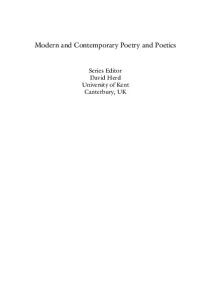The Environmental Imaginary in Brazilian Poetry and Art
This study contributes to ongoing discussions on the connections between the environmental imaginary and issues of identity, place and nation. Utilizing a delimited ecocritical approach, McNee puts Brazilian culture, through the work of contemporary poets
- PDF / 1,431,608 Bytes
- 206 Pages / 595 x 842 pts (A4) Page_size
- 14 Downloads / 247 Views
Please respect intellectual property rights This material is copyright and its use is restricted by our standard site license terms and conditions (see palgraveconnect.com/pc/connect/info/terms_conditions.html). If you plan to copy, distribute or share in any format, including, for the avoidance of doubt, posting on websites, you need the express prior permission of Palgrave Macmillan. To request permission please contact [email protected].
Literatures, Cultures, and the Environment
Literatures, Cultures, and the Environment focuses on new research in the Environmental Humanities, particularly work with a rhetorical or literary dimension. Books in this series seek to explore how ideas of nature and environmental concerns are expressed in different cultural contexts and at different historical moments. They investigate how cultural assumptions and practices as well as social structures and institutions shape conceptions of nature, the natural, species boundaries, uses of plants, animals, and natural resources, the human body in its environmental dimensions, environmental health and illness, and relations between nature and technology. In turn, the series aims to make visible how concepts of nature and forms of environmentalist thought and representation arise from the confluence of a community’s ecological and social conditions with its cultural assumptions, perceptions, and institutions. Such assumptions and institutions help to make some environmental crises visible and conceal others, confer social and cultural significance on certain ecological changes and risk scenarios, and shape possible responses to them. Across a wide range of historical moments and cultural communities, the verbal, visual, and performing arts have helped to give expression to such concerns, but cultural assumptions also underlie legal, medical, religious, technological, and media-based engagements with environmental issues. Books in this series will analyze how literatures and cultures of nature form and dissolve; how cultures map nature, literally and metaphorically; how cultures of nature rooted in particular places develop dimensions beyond that place (e.g., in the virtual realm); and what practical differences such literatures and cultures make for human uses of the environment and for historical reshapings of nature. The core of the series lies in literary and cultural studies, but it also embraces work that reaches out from that core to establish connections to related research in art history, anthropology, communication, history, philosophy, environmental psychology, media studies, and cultural geography. A great deal of work in the Environmental Humanities to date has focused on the United States and Britain and on the last two centuries. Literatures, Cultures, and the Environment seeks to build on new research in these areas, but also and in particular aims to make visible projects that address the relationship between culture and environmentalism from a comparative perspective, or that engage with regions, cultures, or histo
Data Loading...











